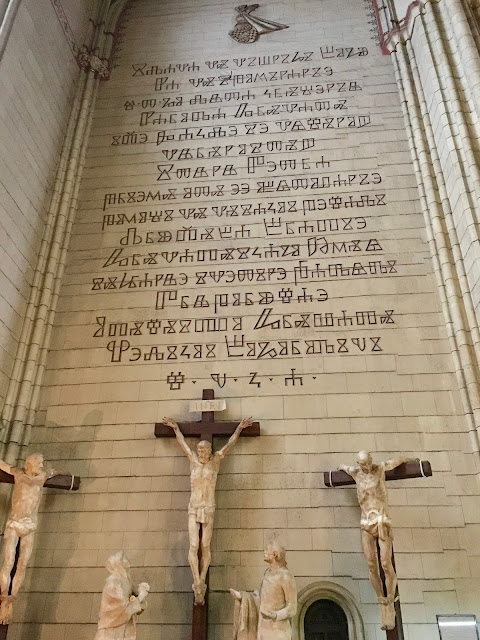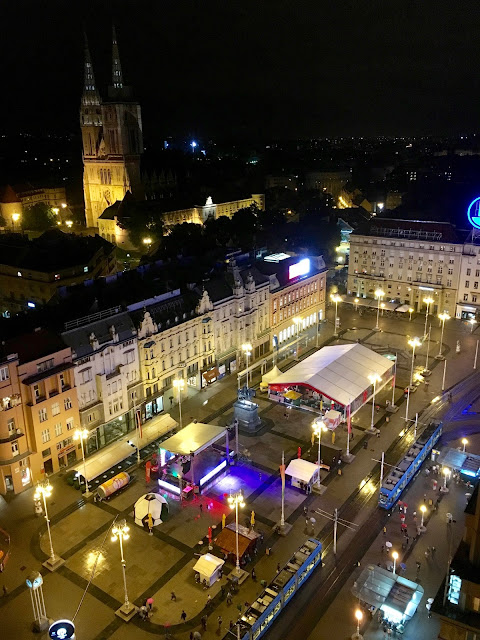 |
| Zagreb, Croatia |
I was gutted to be leaving Bosnia behind. My final hours there were spent dozing on and off as my bus wound its way through pretty little villages, their few lights illuminating an otherwise black countryside. The mighty peaks of the Dinaric Alps rose invisibly all around. Gradually they vanished too, and shortly afterwards, the bus passed through Banja Luka, the capital of the Republika Srpska. At Bosanska Gradiška, the first soft pink glow of sunrise tinted the river Sava with a touch of colour as I crossed the bridge into Croatia. The customs procedures were swift; the Croatian border guard was more scrutinising of the former Yugoslav passports than of my British one. Once more on smooth, straight roads, I fell into a welcome slumber.
I arrived in Zagreb at 0700. It was already broad daylight.
I grabbed a burek and went into the
city to explore a little whilst I waited for my friend Andrew, who was due to
arrive on a bus from the Czech Republic in a couple of hours’ time. When he
eventually arrived, he was tired and moody, evidently not having enjoyed his
overnight bus. By now, I had had a decent look around and was able to lead him
directly to our hostel, conveniently located between the bus station and the
city’s main square, where we left our bags. We then went on to a café to relax
and come up with a plan for the day.
Andrew and I had not originally intended to travel together
but it had happened that we were planning on being in the same region at the
same time so it made sense to combine our ideas. Having done a fairly
comprehensive tour of Slovenia and the northern half of Croatia’s coast, from the
triangular peninsula of Istria down to Krka National Park near Šibenik, my aim
had been to see a bit of Serbia and Bosnia and then visit the southern part of
Croatia. His aim was to visit a new country, spend a bit of time by the sea and
then cross over to Italy to stay with friends. Croatia, then, was to be more
laidback and less strenuous than my first few days. (When I am travelling
alone, I tend to walk too much, try to see everything, and relax too little).
Zagreb proved a great place to start.
It is a very different place to the more familiar Croatian
coastal settlements, those charming red roofed labyrinths that sit beside stony
beaches and the twinkling azure sea. Zagreb is rather a smaller and altogether
more manageable Vienna or Budapest. At its centre is Trg bana Josip Jelačić (Ban Josip Jelačić Square), pedestrianised
but for the blue trams that roll through it. The wealth gap between this city
and my previous destination is clear. Where Sarajevo has a soundtrack of Balkan
music and scenes of old men in large tunics and black waistcoats chatting
outside its mosques, cosmopolitan Zagreb's core was replete with Western chain
shops, its inhabitants stylish and trendy. Somewhere between the Bosnian
mountains and here, I had undoubtedly crossed into Central Europe. This was
saddening. I had been captivated by Sarajevo. Zagreb was a lovely city indeed
in its own right. But it wasn't memorably unique. Some parts of it were
reminiscent of Prague, in other ways it was like Munich, and in still others it
reminded me of Bratislava. This should not have come as a surprise, since
northern Croatia was far more integral to the old Austro-Hungarian empire than
Bosnia, and had been much longer influenced by Vienna. I liked Zagreb
immensely, but it was unfortunate that I went there so soon after visiting the
compelling city of Sarajevo. This place just wasn't as delightfully
idiosyncratic. I was already blindly nostalgic.
 |
| The Dolac market |
To remedy this, Andrew and I drank up our coffees and headed for the Dolac farmers' market, where we spent a pleasant bit of time idly chatting and sampling the fresh fruit that was on offer. At its top end, the stalls stop selling food and becomes a flower market, then this too evolves into a short parade of souvenir stands as one approaches the cathedral. This brilliant white gothic edifice with its twin spires, one currently under scaffolding, is the country's tallest building. Croatia and its neighbour Slovenia are the only predominantly Catholic states in the Balkans; everywhere south and east of them is typically Orthodox or Muslim. This cathedral is, a little predictably, Catholic, although its interior contained one curious feature that is certainly not typical of most Catholic places of worship. When I was in Serbia and to a lesser extent in Bosnia too, I was readily exposed to the Cyrillic alphabet as well as the Latin one. Now, in the centre of Zagreb, I found the Glagolitic script, the invention of Saints Cyril and Methodius and the precursor to the Cyrillic letters that are used in much of the Slavic world. Developed in today's Moravia, Glagolitic was designed to represent the sounds of the Slavic tongue to facilitate the spread of Christianity into the Slavic sphere. After the saints' deaths in the late 9th century, the students of Cyril and Methodius propagated a refined version of the alphabet, known as Early Cyrillic. More refinement and reforms saw this develop into today's various Cyrillic alphabets. In Croatia alone, Glagolitic remained in popular use for liturgical purposes, up to the 19th century. It is an alien script. Of its 41 known letters, only the characters Ⱎ and Ⰵ bear any resemblance to modern Cyrillic letters, looking like Ш and Э respectively. (The latter letter is used in Russian and Belarusian but not the South Slavic languages). The inscription inside the cathedral is sadly not ancient, dating back to 1941 and commemorating the 1300th anniversary of the Croatian people’s conversion to Christianity.
 |
| Zagrebačka katedrala (Zagreb Cathedral) |
 |
| The Glagolitic script in Zagreb Cathedral |
 |
| Crkva sv. Marka (Church of St Mark) |
 |
| Zagreb seen from Gradec; on the left is the cathedral and on the right, the Zagreb Eye's tower |
Leaving the cathedral, Andrew and I explored the historic area of Gradec, just a few minutes’ walk north of Ban Jelačić Square, on the Gornji Grad hill. The government district of the city, its streets had plenty of Baroque buildings but compared to the teeming streets full of outdoor cafés in the city below, this felt like a small town in Bohemia. The focal point is the Church of St Mark, which is admittedly very pretty and features a wonderful tiled roof. However, the views from this slightly elevated position overlooked too many unattractive backs of buildings to be considered decent. For that, we needed to get some real height. For 30 kuna (£3.16) each, we ascended to the 16th floor of a small skyscraper on one corner of Ban Jelačić Square, where there is an observation deck called Zagreb 360˚ – Zagreb Eye. From here, there were genuinely great views, particularly to the north towards Gradec and beyond that, the hills between the city and the Slovenian border. To the south, the city unfolded. Zagreb is not ugly, but its southern areas and high rises offer somewhat blander views than may be found in other cities. Nevertheless, it was an enjoyable visit and we resolved to return later in the day, as the basic admission price included multiple entries.
By this stage, a big screen was on in Ban Jelačić Square and
a small crowd was livening up with the prospect of a historically pertinent
football match. In a fixture that has not occurred at a major tournament since
the 1934 World Cup, Austria were playing Hungary as both teams made their Euro
2016 bow. The two nations had had a dual monarchy during the years of the
Austro-Hungarian Empire, the Central European powerhouse that had once ruled
Zagreb. I remained relatively neutral, and was wondering which of their two
close neighbours the Croatian spectators would support. I never really got an
answer because most people’s cheers and gasps were drowned out by two
ultra-loyal Magyars, dressed head to toe in red, white and green, yelling
vociferously at every twist and turn in the game, silent only when slurping
from their beer cans. In a stellar return to a big competition after a thirty
year absence, the Hungarians won the game 2-0 and would go on to top their
group ahead of England’s vanquishers Iceland and eventual champions Portugal.
The Hungarian fans were ecstatic. The Croatians and other neutrals didn’t care
so much; I was intrigued to see how different the atmosphere might be when
Croatia played in three days’ time.
 |
| Ban Jelačić Square ahead of the game |
There was more football on over supper, but our main point of discussion was the general rude demeanour of many of the Croatians we met. It was difficult to make a fair assessment because this was, after all, only our first day in the country. Furthermore, waiters and shop attendants are often busier and less personable in large cities than they are in smaller places with a slower pace of life. Either way, our waiters in the cafés and restaurants we stopped at were often rather short with us. Something that added to this perceived brusqueness was that they would invariably present us with the bill at the moment of service, whether ordering a quick drink or an entire meal. It really came across as though we were being told, ‘Right, here’s your drink. Here’s your receipt. Get it down your neck, pay up and p*** off.’ In actual fact, we later discovered that in Croatia, there is no obligation to pay for such food or drink until a receipt has been presented. This unfamiliar custom became a regular feature of our time in the country, and could get a little confusing. If ordering a drink, a main course, another drink and then a pudding, each particular order would be served with its own receipt, appearing to suggest that we were continually outstaying our welcome and that each new bill was like an addendum to the original order. The one advantage of the system, I suppose, is that if one had roughly the correct combination of notes and coins, one needn’t wait to catch a waiter’s eye to ask for the bill, a process that is very often the slowest and most tedious part of the night.
Before heading in for the night, we paid a second visit to the Zagreb Eye, this time able to look out upon the city’s evening lights. The views of the historic quarter were diminished in the darkness, but the cathedral looked pretty and the ugliness of the less attractive portions of Zagreb had been pleasingly obscured. Despite the calmness of the night down below, it was breezy at the top as the wind whipped around the sides of the tower. After taking in as much of the scene as we wanted, we descended back to ground level to warm up and get some rest. Tomorrow was to be a busy day as we left the city behind and made for the coast, with a stopover at one of Croatia’s great beauty spots, Plitvice.






No comments:
Post a Comment